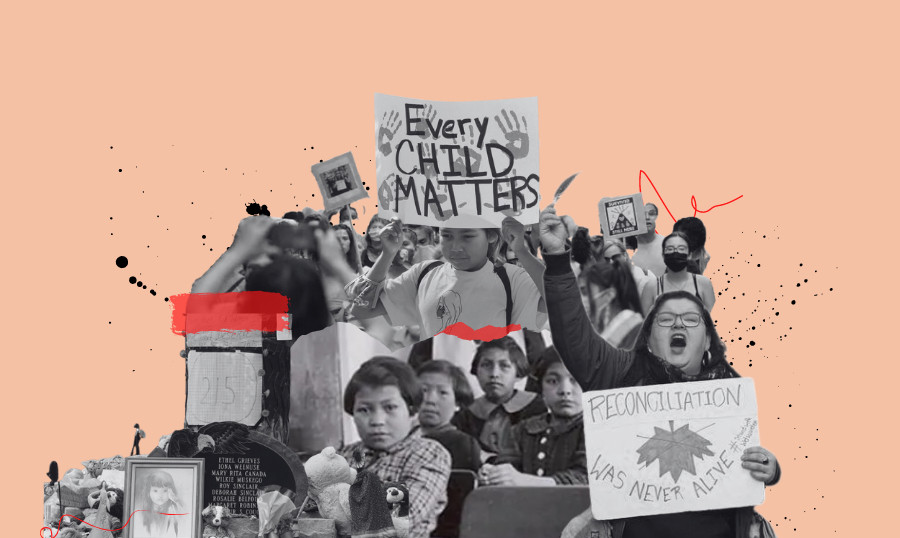Following the confirmation of 215 unmarked graves of Indigenous children in Kamloops, B.C., the creation of the new federal statutory holiday was approved by Parliament days later.
Businesses that fall under the public sector such as banks and post offices will be closed on this day.
But only three provinces (Manitoba, Nova Scotia and PEI) plan to designate the day as a holiday officially, closing schools and government offices. In all other provinces, it's up to employers whether they want to give the day off.
Previously, the day was designated as Orange Shirt Day to commemorate residential school survivor Phyllis Webstad in 2013. She was only six years old when she was placed in a residential school in British Columbia in 1973, and forced to remove the orange shirt her grandmother had purchased for her on her first day.
Webstad says the colour orange has served as a reminder of her experiences, “how my feelings didn’t matter, how no one cared and I felt like I was worth nothing. All of us little children were crying and no one cared.”
Her story has since been a catalyst for change that inspired the Orange Shirt Day movement, raising the voices of Indigenous peoples and displaying solidarity throughout the country.
This year, residential school survivor and proclaimed warrior Geraldine Shingoose asks that Canadians take a moment of silence at 2:15 p.m., in alignment with the number of unmarked graves confirmed in Kamloops. Shingoose has taught her lived experiences of residential schools in Manitoba classrooms for the last six years.
{https://twitter.com/LeeShingoose/status/1441396368833081346}
The National Centre for Truth and Reconciliation also unveiled a survivor’s flag, made up of nine components that were significant to over 30 residential school survivors from across Canada. The survivor's flag is an integral part of the reconciliation process and is meant to help gain recognition of the Indigenous children that were subjected to cruel treatment within residential schooling. The number of identifiable children who are documented as having died at residential schools is in the thousands.
On the path to healing, we stand with First Nations, Inuit and Métis Peoples.
When they buried the children
What they didn’t know
They were lovingly embraced by the land.
Held and cradled in a mother’s heart.
The trees wept for them, with the wind.
They sang mourning songs their mothers didn’t know to sing.
Bending branches to touch the earth around them.
The Creator cried for them, the tears falling like rain.
Mother Earth held them until they could be found.
Now our voices sing the mourning songs. With the trees. The wind.
Light sacred fire - ensure they are never forgotten, as we sing justice.
~Abigail Echo-Hawk, Pawnee storyteller, spoken word artist, researcher and activist.
Ways to Commemorate the Day
- Learn about the significance of land acknowledgements and research the land in your area
- Watch films and documentaries that reflect on the residential school experience – the National Film Board of Canada offers a diverse collection of Indigenous-made films
- For book-lovers, the Toronto Public Library has curated a list of Indigenous must-reads for adults, teens and children
- Attend Indigenous cultural events open to the public, such as Remember Me: A National Day of Remembrance, a national gathering to remember Indigenous children and families affected by Indian Residential Schools and all Indigenous child apprehension programs, will be live-streamed Sept. 30 at 11 a.m
- Buy an orange shirt from an Indigenous artist or company that supports Indigenous causes, such as Old’s Cool General Store which directs proceeds to Anishnawbe Health Toronto or directly through the Orange Shirt Society
- Educate yourself on the nature of residential schools by taking a tour of former sites, such as those offered by the Woodland Cultural Centre
- Learn about Mohawk Village Memorial Park which will honour the children who attended the Mohawk Institute Indian Residential School that operated from 1834 to 1970
- Implement the Truth and Reconciliation Commission of Canada’s Calls to Action and the National Inquiry on Missing and Murdered Indigenous Women and Girls Calls for Justice while encouraging others to do so as well
It's worth noting though, that while the federal government has implemented this holiday, they are fighting Indigenous people at the same time. Just yesterday a court upheld a 2019 ruling that Ottawa must pay $40,000 (the maximum compensation) to First Nations children who were unnecessarily taken into care on or after Jan. 1, 2006. More than 54,000 First Nations children could be eligible for compensation. But the government has spent over $4 million dollars in court trying to strike down that decision.
Some positive news came yesterday, with Ontario mandating Indigenous learning in schools from grade 1 to 3.
The curriculum will include:
- The role of family and resilience in First Nations, Métis and Inuit communities and nations
- First Nations, Métis and Inuit historical and contemporary realities
- Indigenous peoples’ interrelationship and connection with the land
- The residential school system and the reclamation and revitalization of identity, language, culture and community connections.
The province will also be offering Inuktitut as a language of instruction at elementary and secondary levels within Ontario’s Indigenous languages curriculum.

 By
By 





